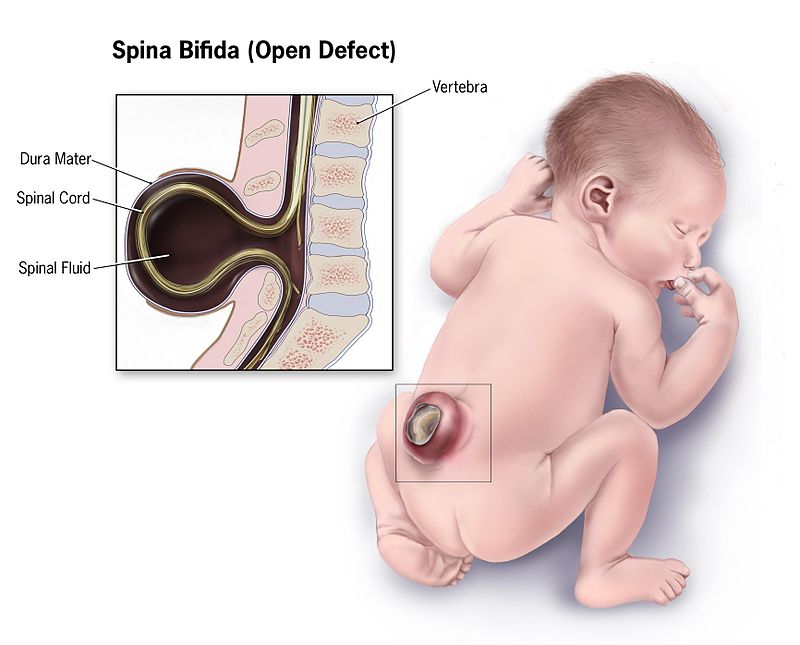Neural tube defects (NTDs) are a group of conditions in which an opening in the spinal cord or brain remains from early in human development. In the 3rd week of pregnancy called gastrulation, specialized cells on the dorsal side of the embryo begin to change shape and form the neural tube. When the neural tube does not close completely, an NTD develops.
Specific types include: spina bifida which affects the spine, anencephaly which results in little to no brain, encephalocele which affects the skull, and iniencephaly which results in severe neck problems.
NTDs are one of the most common birth defects, affecting over 300,000 births each year worldwide. For example, spina bifida affects approximately 1,500 births annually in the USA, or about 3.5 in every 10,000 (0.035% of US births), which has decreased from around 5 per 10,000 (0.05% of US births) since folate fortification was started. The number of deaths in the USA each year due to neural tube defects also declined from 1,200 before folate fortification was started to 840.
There are two types of NTDs: open, which are more common, and closed. Open NTDs occur when the brain and/or spinal cord are exposed at birth through a defect in the skull or vertebrae (back bones). Examples of open NTDs are anencephaly, encephaloceles, hydranencephaly, iniencephaly, schizencephaly, and spina bifida. Rarer types of NTDs are called closed NTDs. Closed NTDs occur when the spinal defect is covered by skin. Common examples of closed NTDs are lipomyelomeningocele, lipomeningocele, and tethered cord.
Anencephaly
Anencephaly (without brain) is a neural tube defect that occurs when the head end of the neural tube fails to close, usually during the 23rd and 26th days of pregnancy, resulting in an absence of a major portion of the brain and skull. Infants born with this condition are born without the main part of the forebrain—the largest part of the cerebrum—and are usually blind, deaf and unconscious. The lack of a functioning cerebrum will ensure that the infant will never gain consciousness. Infants are either stillborn or usually die within a few hours or days after birth.
Encephaloceles
Encephaloceles are characterized by protrusions of the brain through the skull that are sac-like and covered with membrane. They can be a groove down the middle of the upper part of the skull, between the forehead and nose, or the back of the skull. Encephaloceles are often obvious and diagnosed immediately. Sometimes small encephaloceles in the nasal and forehead are undetected.
Hydranencephaly
Hydranencephaly is a condition in which the cerebral hemispheres are missing and instead filled with sacs of cerebrospinal fluid.
Iniencephaly
Iniencephaly is a rare neural tube defect that results in extreme bending of the head to the spine. The diagnosis can usually be made on antenatal ultrasound scanning, but if not will undoubtedly be made immediately after birth because the head is bent backwards and the face looks upwards. Usually the neck is absent. The skin of the face connects directly to the chest and the scalp connects to the upper back. The infant will usually not survive more than a few hours.
Spina bifida
Spina bifida is further divided into two subclasses, spina bifida cystica and spina bifida occulta.
Spina bifida cystica
This includes meningocele and myelomeningocele. Meningocele is less severe and is characterized by herniation of the meninges, but not the spinal cord, through the opening in the spinal canal. Myelomeningocele involves herniation of the meninges as well as the spinal cord through the opening.
Spina bifida occulta
In this type of neural tube defect, the meninges do not herniate through the opening in the spinal canal. It is a common condition, occurring in 10–20% of otherwise healthy people[citation needed]. By definition, spina bifida occulta means hidden split spine. The most frequently seen form of spina bifida occulta is when parts of the bones of the spine, called the spinous process, and the neural arch appear abnormal on a radiogram, and is generally harmless. Usually the spinal cord and spinal nerves are not involved. The risk of recurrence in those who have a first degree relative (e.g. parent, sibling) is 5–10 times greater than that in the general population. The genetic risk of recurrence with symptomatic forms of spina bifida occulta is uncertain.
For more info
National Institute of Neurological Disorders and Stroke (NINDS)
NINDS Encephaloceles Information Page
NINDS Spina Bifida Information Page
NINDS Anencephaly Information Page
NINDS Iniencephaly Information Page
Neural tube defect. (2016, August 8). In Wikipedia, The Free Encyclopedia. Retrieved 02:22, August 8, 2016, from https://en.wikipedia.org/w/index.php?title=Neural_tube_defect&oldid=733475432

